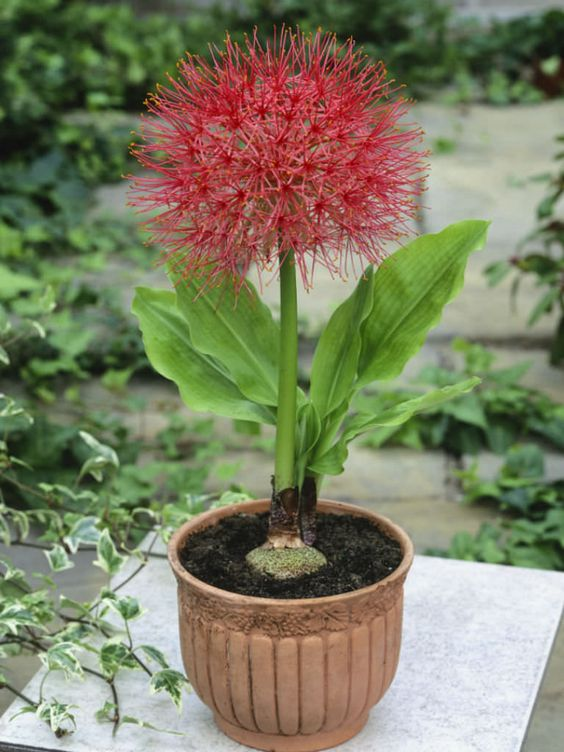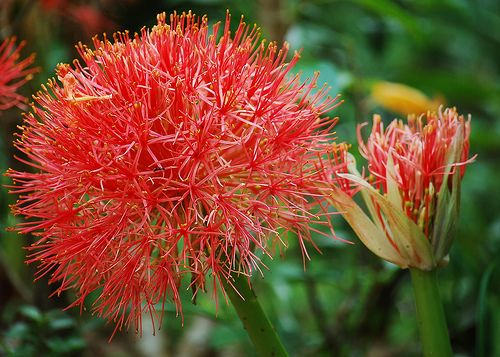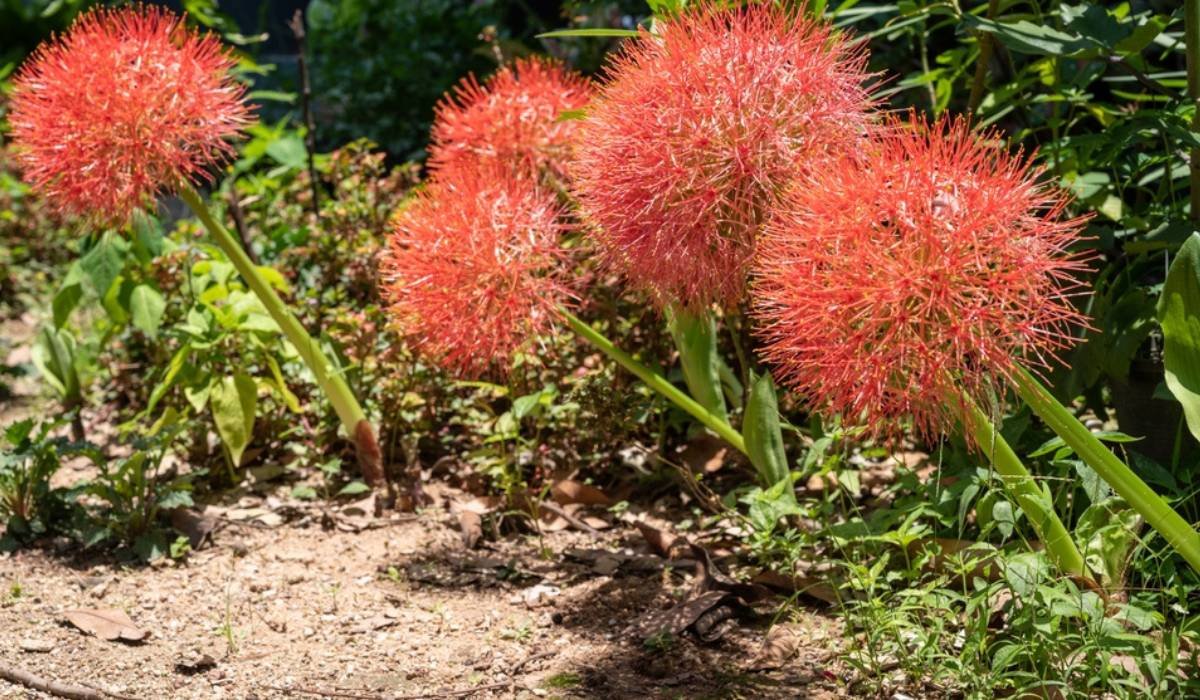Football lily flowers, also known as Scadoxus Multiflorus, are grown for their allure and lovely beauty. Because planting this flowering plant using bulbs is simple, most people choose to do so. Scadoxus Multiflorus is also known as a poisonous plant because of its potentially hazardous and poisonous roots. Therefore, before planting, care should be given to avoid touching the roots and to use gloves. Read on to learn more about Scadoxus Multiflorus flowers and how to grow and maintain them.
See also: How to grow and care for Rain Lilies?
What is Scadoxus Multiflorus flower?
Formerly called Haemanthus Multiflorus, Scadoxus Multiflorus flowers resemble vibrant red fireballs or fireworks. With large, spherical flower heads, these perennial plants comprise red, star-shaped florets featuring yellow-tipped stamens. Serving as a major attraction for birds, bees, and butterflies, Scadoxus flowers have smooth stems with no foliage. They have bright green semi-succulent leaves and produce red berries in the fall.
Scadoxus Multiflorus: Key facts
| Botanical Name | Scadoxus Multiflorus |
| Common Name | Blood Lily, African Blood Lily, Fireball Lily, Football Lily Flowers |
| Plant Type | Perennial |
| Mature Size | 24 in. tall, 15 in. wide |
| Sun Exposure | Partial |
| Soil Type | Loamy, sandy, moist but well-drained |
| Soil pH | Acidic, neutral, alkaline |
| Bloom Time | Summer, Fall |
| Flower Colour | Red |
| Native Area | Africa |
| Toxicity | Toxic to pets |
The seeds should be spread out on the potting soil’s surface
See also: All about Striped Barbados Lily
What is the common name of Scadoxus Multiflorus?
As mentioned above, Scadoxus Multiflorus has several common names. These include Blood Lily, Fireball Lily, African Blood Lily, Powderpuff Lily, and Catherine Wheel.
How to grow Scadoxus Multiflorus?
As long as they are kept dormant over the winter and somewhat dry, these bulbous perennials are simple to grow. For July colour bursts, Scadoxus Multiflorus can be planted in protected, warm borders in the late spring. Scadoxus multiflorus should be grown in humus-rich, well-drained soil in full sun or light shade in a protected area for optimal results. Before the first frost in the fall, dig out the bulbs, pot them up, and store them in a frost-free area like a conservatory or greenhouse. Scadoxus Multiflorus could also be raised year-round in a portable pot that can be moved about as needed.

Source: Pinterest
- Once the berries have fallen off or dropped when touched, harvest the seeds from the fruit. If this occurs, take out the berry flesh to get the seeds.
- The seeds should be spread out on the potting soil’s surface.
- The seeds will initially germinate as a bulb before sprouting. Maintain soil moisture while letting the bulb go dormant. In a few months, growth should become evident.
- When the Scadoxus Multiflorus bulb has sprouted, place it in a container or an appropriate outdoor spot that is warm enough (above 60 degrees Fahrenheit) and has enough light exposure.
Potting of Scadoxus Multiflorus
Scadoxus Multiflorus doesn’t need to be replanted frequently. In actuality, blood lily blooms best when left alone. If you must, carefully pry the plant out of its container, being careful not to damage its root system. Put Scadoxus Multiflorus in a fresh container and repot it with a potting soil and sand mixture. Water the plant liberally and let excess moisture run off.
How to care for Scadoxus Multiflorus?
- It can be planted inside or outdoors, in pots or directly in the ground.
- In the spring, plant the bulbs in a mixture of manure and loam or sand.
- Maintain a distance of up to 10 inches.
- Replant occasionally in early summer or spring.
Scadoxus Multiflorus: Ideal growing conditions
When planning to grow Scadoxus Multiflorus plants, make sure the conditions are ideal for their growth and survival.
Scadoxus Multiflorus: Sunlight needs
Due to the blood lily’s poor tolerance for intense sunlight, bright, indirect light exposure or partial sun is preferable. These plants benefit greatly from afternoon shade because it shields them from the damaging effects of the hot afternoon sun.
Scadoxus Multiflorus: Soil needs
The blood lily thrives in nutrient-rich loamy or sandy soil. Since these plants do poorly in damp soil, it is crucial that these soil types have sufficient drainage.
If plants are being potted, combine sand and rich potting soil. This mixture will provide excellent drainage and allow the soil to keep moist, which is crucial for a healthy plant.
Scadoxus Multiflorus: Water needs
Avoid overwatering blood lily plants as they have moderate watering requirements. Depending on the stage of growth of the plant, you should water a blood lily differently at different times.
Water the plant frequently while it is actively growing to maintain a wet soil environment. However, if the plant starts to fall dormant, cease watering it regularly and let it wither away. Water simply enough to keep the soil and dormant plant from entirely drying out. As soon as the plant starts to grow once more, increase watering.
Scadoxus Multiflorus: Uses
Scadoxus Multiflorus is indigenous to tropical east and south Africa. It is cultivated for its stunning blood-red inflorescences, the source of its popular name, blood lily. Where the environment is acceptable, Scadoxus Multiflorus is planted as an ornamental plant at homes for its vividly coloured flowers, either in pots or in the ground.
Tips and tricks to grow Scadoxus Multiflorus
- For proper growth, Scadoxus Multiflorus needs well-drained soil. This plant doesn’t require a lot of water, so it should not be overwatered.
- Only water plants until the topsoil is completely dry. Conditions that are damp and moist are not good for this plant.
- After blooming, Scadoxus Multiflorus enjoy being in areas with some shade or light. However, they require full sunlight for a few hours each day before blooming.
- Vermicompost or any other compost should be utilised for its proper growth.
- Every 30 to 40 days, 50 to 70 grams of vermicompost should be administered.

Source: Pinterest
Scadoxus Multiflorus toxicity: Is it poisonous?
Scadoxus Multiflorus is considered toxic to both humans and animals. If ingested, it can cause an upset stomach. It’s highly advisable to grow Scadoxus Multiflorus where it can’t be reached by children and pets.
Scadoxus Multiflorus: Price
You can easily buy Scadoxus Multiflorus plants online. The prices vary depending on a range of factors. They usually start from Rs 150 per plant.
FAQs
Why is Scadoxus Multiflorus kept in homes?
Due to its vividly coloured blossoms, it is grown as an ornamental plant.
Is Scadoxus Multiflorus an indoor plant?
Yes, it is an indoor plant.
Housing News Desk is the news desk of leading online real estate portal, Housing.com. Housing News Desk focuses on a variety of topics such as real estate laws, taxes, current news, property trends, home loans, rentals, décor, green homes, home improvement, etc. The main objective of the news desk, is to cover the real estate sector from the perspective of providing information that is useful to the end-user.
Facebook: https://www.facebook.com/housing.com/
Twitter: https://twitter.com/Housing
Email: [email protected]











